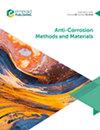研究了不同含量的不纯CaO对电熔氧化镁工艺的影响
IF 2.6
4区 材料科学
Q2 METALLURGY & METALLURGICAL ENGINEERING
引用次数: 0
摘要
目的研究不同氧化钙含量对电熔氧化镁过程的影响。设计/方法/方法采用有限元模拟分析了镁砂熔融过程,并用扫描电镜对其进行了验证。结果表明:随着CaO含量的增加,最大升温幅度从3,616°C增加到3,729°C,呈近似非线性演化;CaO的低导热系数和低比热导致较高的温度。随着CaO含量的增加和温度的升高,MgO渣的最大流动速度由0.043 mm/s增加到1.34 mm/s。不同初始CaO含量下,CaO体积分数的分布趋势基本相同,炉内CaO体积分数均匀分布在50 ~ 225 mm之间。分析了不同杂质氧化钙含量对电熔氧化镁工艺的影响,建立了理论体系。本文章由计算机程序翻译,如有差异,请以英文原文为准。
Study on the influence of different contents of impure CaO on the process of electromelting magnesia
Purpose The aim of this study is to report the effect of different content of calcium oxide on the process of electromelting magnesia. Design/methodology/approach The process of molten magnesia was analyzed by finite element simulation and proved by scanning electron microscope. Findings The results show that with the increase of CaO content, the maximum temperature appreciation increases from 3,616°C To 3,729°C, showing an approximate nonlinear evolution. Low thermal conductivity and low specific heat of CaO result in higher temperature. With the increase of CaO content and temperature, the maximum flow velocity of MgO slag increases from 0.043 to 1.34 mm/s. Under different initial CaO contents, the distribution trend of CaO volume fraction is basically the same, and the CaO volume fraction is evenly distributed between 50 and 225 mm in the furnace. Originality/value The influence of different contents of impurity calcium oxide on the process of electromelting magnesia was analyzed and a theoretical system was established.
求助全文
通过发布文献求助,成功后即可免费获取论文全文。
去求助
来源期刊

Anti-corrosion Methods and Materials
工程技术-冶金工程
CiteScore
2.80
自引率
16.70%
发文量
61
审稿时长
13.5 months
期刊介绍:
Anti-Corrosion Methods and Materials publishes a broad coverage of the materials and techniques employed in corrosion prevention. Coverage is essentially of a practical nature and designed to be of material benefit to those working in the field. Proven applications are covered together with company news and new product information. Anti-Corrosion Methods and Materials now also includes research articles that reflect the most interesting and strategically important research and development activities from around the world.
Every year, industry pays a massive and rising cost for its corrosion problems. Research and development into new materials, processes and initiatives to combat this loss is increasing, and new findings are constantly coming to light which can help to beat corrosion problems throughout industry. This journal uniquely focuses on these exciting developments to make essential reading for anyone aiming to regain profits lost through corrosion difficulties.
• New methods, materials and software
• New developments in research and industry
• Stainless steels
• Protection of structural steelwork
• Industry update, conference news, dates and events
• Environmental issues
• Health & safety, including EC regulations
• Corrosion monitoring and plant health assessment
• The latest equipment and processes
• Corrosion cost and corrosion risk management.
 求助内容:
求助内容: 应助结果提醒方式:
应助结果提醒方式:


